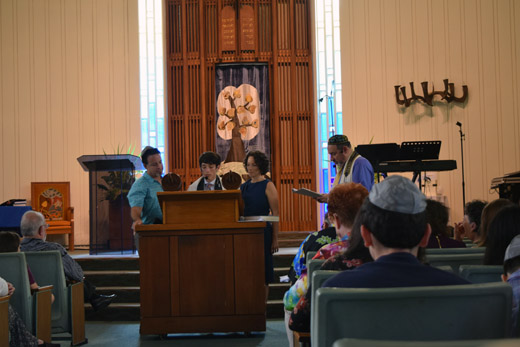
Editor’s Note: This is the 34th in a series of stories researched during Don and Nancy Harrison’s 50th Wedding Anniversary cruise from Sydney, Australia, to San Diego. Previous installments of the series, which runs every Thursday, may be found by tapping the number of the installment: 1, 2,3,4, 5, 6, 7,8, 9, 10, 11, 12,13, 14,15, 16, 17, 18,19,20, 21, 22, 23, 24, 25, 26, 27, 28, 29, 30, 31, 32, 33
By Donald H. Harrison

HONOLULU, Hawaii — By fortuitous circumstance, our cruise ship MS Maasdam was pier-side in Honolulu on a Saturday morning, and Nancy and I had plenty of time to make our way to Temple Emanu-El, a Reform congregation at 2550 Pali Highway, for Shabbat services. As it turned out, we couldn’t have picked a better day to learn about the congregation, because it was bar mitzvah day for Ezra Henry Levinson, whose distinguished family not only had helped to found this Reform congregation but counted within its ranks two former justices on the Hawaiian Supreme Court, Bernard Levinson, and his nephew, Steve Levinson.
Ezra’s great-great uncle, Bernard Levinson, had been president of the congregation between 1950 and 1960, the year that the congregation moved into the building where the bar mitzvah was now occurring. Steve, who is Bernard’s nephew, had followed in Bernard’s footsteps.
Ezra, evidently, is a very popular young man, as the sanctuary was filled with school friends in addition to congregants. Before Ezra started reading from the Torah, Rabbi Ken Aronowitz explained that the Torah, written in Hebrew on parchment, contained the first Five Books of the Bible. He invited anyone interested in seeing what a Torah scroll looked like to come up to the bima and look over Ezra’s shoulder before the reading began. Fully two-thirds of the attendees did just that!
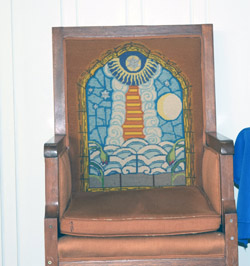
As Ezra chanted his portion–and very well, I might add– my gaze wandered to the bima on which the chairs for the machers were upholstered in Hawaiian-style fabric, and then over to the left side of the sanctuary where, sheltered from direct sunlight by stained glass windows, was an encased Torah which once had been the property of the Hawaiian royal family.
Following the service, the bar mitzvah boy’s parents, Elila (Stone) and Josh Levinson, graciously sponsored a kiddush, at which we had the opportunity not only to wish Ezra and his family a mazel tov, but also to chat both with Rabbi Aronowitz and Larry Seth Steinberg, who is the archivist for the synagogue’s Bernard Levinson Archives.
Rabbi Aronowitz, a former sales and marketing person who initially came to Honolulu to learn about Hawaiian healing, was drawn into greater and greater involvement with the congregation. Initially, he started teaching Hebrew school on Sundays and Wednesdays, then was asked to serve as a lay cantor, and eventually became director of the religious school. When he and his wife became adoptive parents, he decided to give up the job as educational director and to focus instead on being a cantorial soloist. When rabbis would take vacation, and when the congregation was between rabbis, he served as spiritual leader.
In 2012, the congregation’s previous rabbi departed, and Aronowitz filled in for him. “I realized that I was well-liked and well regarded, but it would help if I would get some credentials,” he told me. “I really couldn’t see myself leaving Hawaii to go to seminary — not with my family and work here– so I found a program called JSLI, Jewish Spiritual Leaders Institute, based in New York. It allowed me to study and to meet students on line on a weekly basis. I met ordained cantors, longtime educator, and I earned my simcha in 2014. Ever sine I have been the rabbi at Temple Emanu-El.”
In addition to leading the Reform congregation, Aronowitz and his wife belong to the Conservative congregation, Sof Ma’arav, that is located next door. Dual membership is not at all uncommon. For example, Hawaii’s former Jewish, Republican governor, Linda Lingle, prays at both congregations. In a sense, it is like having your choice of minyans. One week you might attend Reform Shabbat services; another week you might attend the Conservative ones. There also is a Chabad congregatin on the island, as well as Jewish services at a Navy chapel.
Aronowitz, who grew up in Pelham, New York (close to my own hometown of New Rochelle, New York), told me that in Honolulu, “There are no Jewish neighborhoods. My kids are Chinese, Japanese, Jewish. ‘Jewish’ here doesn’t necessarily look like Jewish in New York or Los Angeles. We have a beautiful community. We do have a challenge when it comes to kosher foods, but looking at the mountains, the oceans, the beautiful sunsets, or rainbows — we have them in abundance — you realize that this is a beautiful place to be Jewish.”
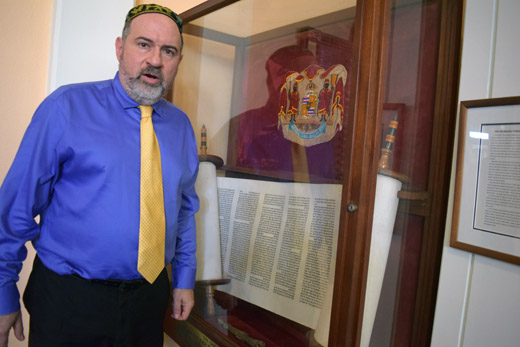
The congregation is involved in such projects as the Honolulu Jewish Film Festival, a communal Passover seder, presenting a series of Broadway shows, and publishes online “Shaloha” — a word combining “Shalom” and “Aloha” — which is a calendar of community events. Aronowitz and the temple’s leadership also are involved in interfaith dialogues. In short, he said, “we are a very caring community.”
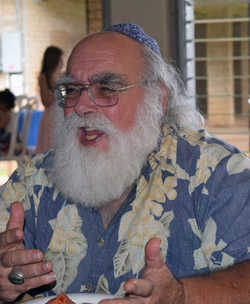
Archivist Steinberg came to Hawaii from Nevada where he served as an historical archaeologist for the Nevada State Museum in Carson City. Of particular interest to him is the Kalakaua Torah now sitting in the corner of Temple Emanu-El’s sanctuary.
He said that the Torah was partially scribed in 1885, but was still incomplete when merchant Elias Abraham Rosenberg brought it to Hawaii in 1886. King David Kalakaua, the second to last of the Hawaiian monarchs, heard of Rosenberg’s arrival, and the two became friends. “They sat at night, played cards, they drank, and the king learned Hebrew from Rosenberg,” Steinberg related.
“Rosenberg left the Torah here with Kalakaua and went back to San Francisco to work on some business opportunity. He caught pneumonia and within a month of leaving here, he passed away in San Francisco. The scroll and the yad (pointer) that came with it passed into Kalakaua’s possession. After he passed away, it was passed down in the royal family, and then on to the ali’i (Hawaiian nobles). It was loaned to the community in 1903 or so, and then in the 1930’s it disappeared. When it turned up again, the yad was donated by Princess Kawanananko for the dedication of the building in 1959, but the scroll had disappeared. Later, an attorney who served on the temple’s board of trustees, Samuel Landau, received the Torah as part of an estate he was settling. He brought it to the rabbi and a professor at the university to determine it was indeed the lost scroll. It had been totally devastated by insects, which ate large portions of the parchment. The congregation put some display rollers on it, and we have had it on display since the 1970s.”
Occasionally the Torah is taken out of the case and rolled to keep it flexible.
Steinberg said there were people in the congregation who wanted to hire a sofer both to finish the unwritten parts of the Torah and to repair the damage it had sustained from insects and weathering. The cost would have been phenomenal, as much as $100,000, according to Steinberg. But it was not the cost, but a sense of obligation to history, that the project was jettisoned.
“The matter came up before the most recent temple board, and what I pointed out was that as an artifact the scroll is properly displayed and it illustrates a moment in history of two civilizations half a world apart coming across each other,” Steinberg said.
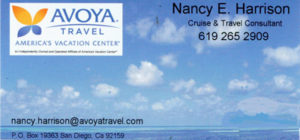 “As for restoration, as soon as you touch an artifact, you have changed it. If you would restore it, you would change its significance; the preservation is no longer there. My suggestion was that we retain it as an artifact, reflecting the coming together of Hawaiian culture and Jewish culture–a story in itself — and not restore it for the pride of having one more scroll, when we have 7 or 8 scrolls already. The board accepted that recommendation.”
“As for restoration, as soon as you touch an artifact, you have changed it. If you would restore it, you would change its significance; the preservation is no longer there. My suggestion was that we retain it as an artifact, reflecting the coming together of Hawaiian culture and Jewish culture–a story in itself — and not restore it for the pride of having one more scroll, when we have 7 or 8 scrolls already. The board accepted that recommendation.”
I mentioned the Hawaiian-flavored design of the chairs on the bimah, to which Steinberg , himself clad in a blue Hawaiian shirt, responded, “If you look at the basket of yarmulkes, you’ll see that families choosing a kippah for a bar or bat mitzvah often go to the Hawaiian theme.”
“It’s one of those things that is in the air in Hawaii,” Steinberg commented.
As Jews seem to gravitate to Hawaiian themes, so too do Hawaiians apparently gravitate to Jews. Besides the two Levinsons who had served on the Supreme Court, and Lingle having served as governor, one of Hawaii’s two U.S. Senators is Brian Schatz, a Jew and a Democrat, whose children attended preschool along with Rabbi Aronowitz’s.
The late U.S. Senator Daniel Inouye was a noted philo-Semite, once giving serious consideration to formally converting to Judaism. He would have too, according to Steinberg, “but his mother wouldn’t let him — that’s what stopped him.”
*
Harrison is editor of San Diego Jewish World. He may be contacted via donald.harrison@sdjewishworld.com
Pingback: Adventures of an Orthodox Jewish bond trader | San Diego Jewish World